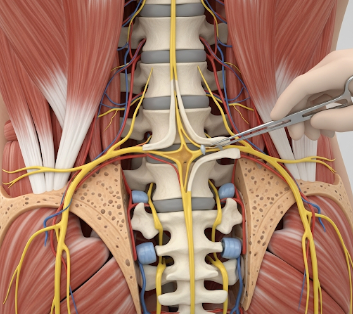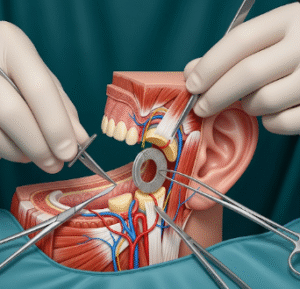What it is
Lumbar decompression surgery is a surgical procedure aimed at relieving pressure on the spinal nerves in the lower back (lumbar spine). The pressure is usually caused by herniated discs, spinal stenosis, bone spurs, or thickened ligaments, which can lead to pain, numbness, or weakness in the legs.
Key points:
- Targets nerve compression in the lumbar spine.
- Can involve laminectomy, discectomy, or foraminotomy, depending on the cause of compression.
- Typically performed when conservative treatments fail to relieve symptoms.
- Often results in improved mobility, reduced pain, and enhanced quality of life.
Why it’s done
Lumbar decompression surgery is indicated for patients with:
- Persistent lower back pain unrelieved by medications or physiotherapy.
- Leg pain, numbness, or weakness due to compressed spinal nerves.
- Spinal stenosis or herniated discs confirmed via MRI or CT scans.
- Loss of bladder or bowel control in severe cases (emergency indication).
- Degenerative spine conditions that interfere with daily activities and sleep.
Note: Surgery is usually considered after conservative therapies such as physiotherapy, medications, or injections have failed.
Alternatives
Other treatment options include:
- Conservative management: Painkillers, anti-inflammatory medications, or muscle relaxants.
- Physical therapy: Strengthening and stretching exercises to support the spine.
- Epidural steroid injections: Reduce inflammation and relieve nerve pain.
- Minimally invasive procedures: Microdiscectomy or endoscopic spine surgery.
- Spinal stabilization surgery: In cases of significant instability.
Important: While non-surgical options may reduce symptoms, surgery may be required for long-term relief or nerve protection.
Preparation
Proper preoperative preparation ensures safety and optimal outcomes:
- Medical evaluation: Blood tests, ECG, imaging (MRI/CT), and anesthetic assessment.
- Medication review: Discontinue blood thinners or certain supplements as advised.
- Lifestyle preparation: Maintain a healthy diet and avoid smoking.
- Informed consent: Discuss procedure details, risks, recovery expectations, and potential complications.
- Preoperative exercises: Strengthen core muscles if recommended by the surgeon.
Patient instructions:
- Fast 6–8 hours before surgery.
- Arrange transport and support at home post-surgery.
- Wear comfortable, loose clothing on the day of surgery.
How it’s done
Lumbar decompression surgery can be performed using open or minimally invasive techniques:
- Anesthesia: General anesthesia is administered.
- Incision: Small (minimally invasive) or larger (open) incision in the lower back.
- Bone or disc removal: Surgeons remove part of the vertebra (lamina), disc material, or bone spurs compressing nerves.
- Nerve decompression: Ensures nerves have adequate space and are free from pressure.
- Closure: Incision is closed with sutures, and sterile dressing is applied.
Duration: Typically 1–3 hours, depending on complexity.
Recovery
Recovery after lumbar decompression surgery involves:
- Hospital stay: Usually 2–5 days depending on surgery type and patient health.
- Pain management: Medications and cold therapy control post-operative discomfort.
- Physical therapy: Begins soon after surgery to restore mobility, strength, and posture.
- Activity restrictions: Avoid heavy lifting, bending, or twisting for several weeks.
- Full recovery: Most patients regain normal function within 6–12 weeks, with ongoing improvement for several months.
Benefits of recovery:
- Relief from leg pain, numbness, or weakness.
- Improved mobility and ability to perform daily activities.
- Reduced dependence on medications for pain relief.
Complications / Risks
Although generally safe, lumbar decompression surgery carries risks:
- Infection: At the incision site or deeper in the spine.
- Bleeding or hematoma formation.
- Nerve injury: Rare, but may result in persistent numbness, weakness, or pain.
- Spinal instability: May require additional surgery.
- Dural tear: Leakage of spinal fluid; usually repaired during surgery.
- Blood clots: Preventive measures include early mobilization and medications.
Prevention:
- Performed by experienced spine surgeons.
- Strict sterile techniques and postoperative monitoring.
- Follow rehabilitation protocols carefully.
Treatment Options in Korea
Lumbar decompression surgery is widely available in Korean hospitals and specialized spine centers:
Key features:
- Performed by experienced orthopedic and neurosurgeons.
- Advanced options include minimally invasive decompression, microdiscectomy, and endoscopic spine surgery.
- Comprehensive care includes preoperative assessment, surgical intervention, and structured rehabilitation programs.
- Postoperative monitoring ensures reduced risk of complications and faster recovery.
- Suitable for patients seeking high-quality spine surgery with excellent outcomes and modern facilities.
Summary: Lumbar decompression surgery in Korea is a safe and effective solution for relieving nerve compression in the lower back. With skilled surgeons, advanced surgical techniques, and comprehensive postoperative care, patients can achieve pain relief, improved mobility, and enhanced quality of life.













